Introduction
Royal, beautiful, and coveted by every admirer, sapphires have an unspoken excellence about them. Primarily known for their riveting and rich blue colour, they’re also available in a whole spectrum of shades. The spell-binding gems have been loved since ages and have been seen in utterly breath-taking jewellery designs. With their delight-evoking glitter and perfectly indulgent hues, they pose as the choices of luxury. But there is so much about them that you don’t know. Here is everything you need to know about these magical gemstones of different colours.
Origin & Supply
Perhaps the most known member of the mineral corundum, these regal jewels come with faint traces of iron, chromium, copper, titanium, or even magnesium. They’re most commonly found in the popular blue colour. However, some natural sapphires are also available in many different colours like yellow, pink, orange, purple, and green. The name “sapphire” can be used for all these colours, but the red variety is called “ruby.” Known birthstone of September, they can also be gifted for the 45th anniversaries. In fact, completion of 65 years is called Sapphire Jubilee!
Sapphire is a stone that can be found in several sources spread across the globe. It is heavily mined from Myanmar, Sri Lanka, Thailand, Cambodia, Tanzania, Madagascar, and even Australia. Little but precious traces of it had been sourced from the Kashmir region of India/Pakistan, which was famously called “Kashmir Blue Sapphire.” However, very little quantity of these precious gems is mined from the region anymore.
How is Sapphire Mined?
As of current employment, there are 3 main procedures to mine the stone. These are explained briefly below:
Open Pit or Shallow Mining In this process, shallow pits of vast size are formed. Large regions are spanned where promising rocks containing the gem are collected. Slabs of the potential boulder-carrying gem are then carried where they can be chiselled. This technique is used in Madagascar and Sri Lanka.
Commercial Mining Done in Thailand and Australia, the mining is done using heavy machinery. These mines are usually quite deep and vast in size, and source both commercial grade as well as gem-quality stones.
Water Pressure Mining Considered to be among the worst techniques, this kind is employed in America and some parts of Africa. Strong pressure of water is applied to the ground bearing the gem. This washes off the mother rock and leaves behind the stone. However, it permanently leaves the land barren and destroyed.

What to Remember While Buying Sapphire?
When you’re in the market to shop for sapphires, there’s a lot you need to know beforehand, so you’re at less risk of getting ripped off. Follow these carefully put-together tips and tricks to get this gemstone for the best value of your buck:
- The more important determinants that affect the value of this stone are its cut, clarity, carat, and colour. Know more and educate yourself a little before you set out buying an expensive stone.
- Know that most of the gemstones in the current market have undergone some kind of treatment. Most sapphires you’ll see will be heat-treated. This is done to improve the colour and clarity of this gem and doesn’t usually decrease the value.
- That said, always ask your dealer for the proof of authenticity. There are other treatments, too, that are not necessarily considered ethical. Ask your jewellery about what treatments the stone has undergone before buying it.
- Sapphires range from light shades to extremely rich and dark tones. You need to keep in mind that the high-prized gem will have medium-dark hue. The gems with colour too dark are also comparatively less in value.
- Study your stone. It is advisable that before buying your gem, you hold it up against the light to study its clarity and colour closely. It is to be noted that sapphires with uneven colour distribution are considered far less precious.
- Know about the different origins of this stone. The place where sapphire was mined also holds a lot of importance. The specimens from Kashmir, Myanmar, or Ceylon are considered to be rarer than the ones otherwise found.
- Sapphire isn’t only available in blue colour, albeit it is the most popular one. Other colours of the stone are orange, pink, green, purple, among more. However, the crystal found in the red colour is called ruby.
- Another important thing to note is the clarity of your gem. The higher-priced and prized sapphires usually have a clear make. That said, small inclusions are considered natural, as long as they don’t affect the transparency of this gem.
- Saturation of colour is yet another factor that affects grade of your stone. Saturation refers to the intensity of colour found in your gem. Sapphires with washed-out of grey colours are usually undesirable. Medium-saturation stone is the high-priced variety.
- Sapphire is one of the hardest gemstones. It ranks 9 on the Mohs Scale of Hardness, closely second to diamond. This means that this cannot be easily shattered or scratched. When you’re evaluating your stone, keep in mind that it shouldn’t be quite as easy to abrade your sparkling gem.

